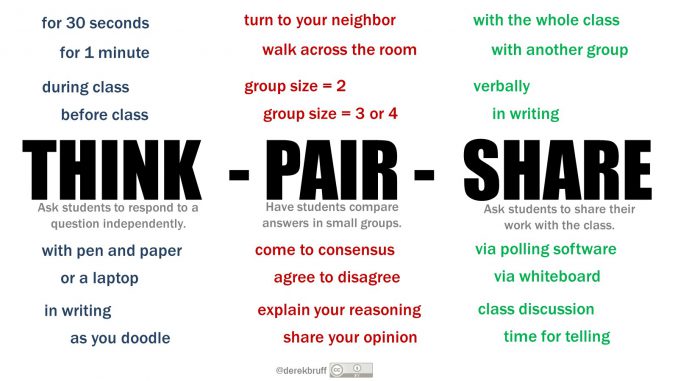
What is it?
Think-Pair-Share is a cooperative learning approach where the whole group is given a single question or prompt to discuss. Students consider the question individually for a few minutes before forming pairs to discuss their responses. Finally they share their thoughts with the wider group.
Why do it?
A major benefit of Think-Pair-Share is the wait time. This initial phase of silent thinking is a crucial opportunity for students to retrieve their prior knowledge and organise their thoughts. This in turn promises to improve the quality of the subsequent discussion and increase participation in the ‘Share’ stage, (Lange et al, 2016; Sampsel, 2013).
The structure gives every student a low-risk opportunity to formulate a response and rehearse expressing it to one other person before ‘going public’. In this way it promotes the equal participation of every student.
It potentially exposes students to points of view and approaches which contrast with their own and bring new perspectives.
How to set it up
- Before the session, develop a stimulating open-ended question – have a go at responding to it yourself (Barkley and Major, p293) – and prepare materials such as slides or artefacts, as needed.
- During the session, introduce the Think-Pair-Share activity, including the hoped-for-benefits.
- Pose the question and ask students to spend a few minutes thinking about it individually, jotting down some notes and preparing their response.
- Next, ask students to pair with another student and share their responses in turn for a further few minutes, noting similarities and differences. If they disagree, encourage them to summarise each other’s positions so they can explain why and how (Barkley and Major, 2018). You may ask them to integrate the ideas into a joint response for the ‘Share’ stage. Let students know whether you will be calling on every pair in the ‘Share’ stage, or inviting volunteers.
- Finally invite the pairs to share their responses with the whole group.
Considerations
Students often sit with friends and may need a reason to bond with peers outside their social network, even though this is beneficial (Todman, 2018). If the room and group size allows, consider intervening to allocate students into pairs you choose. This will give them an opportunity to get to know others outside their social network. As well as helping them bond, students are likely to encounter new perspectives and approaches.
If students start chatting immediately, do emphasise the value of that first silent individual ‘Think’ phase. It gives students the opportunity to retrieve what they know and organise their thoughts about the question, both of which are central to learning and improve the quality of the discussion.
The quality of the conversation will be affected by the difficulty or sensitivity of the question, and the extent to which students feel comfortable making mistakes.
Variations
‘Stump your partner‘ is based on an idea from the Centre for Teaching Innovation at Cornell University for consolidating learning from that session’s lecture, reading, or other didactic material. For the ‘Think’ stage, ask students to individually and silently come up with a question to test their partner and help them to learn. Instruct students to try to stump their partner with a challenging question, but to keep it based on important concepts from the lecture or reading. For the ‘Pair’ stage, ask students turn to a partner and pose their question, followed by a discussion of the responses. Finally, for the ‘Share’ stage, collect the questions to get a sense of what students find central and/or challenging.
How to know if it works
Compared to whole-group discussions without the Think or Pair stages:
- Is there more equal participation? What is the proportion of students participating in the plenary ‘Share’ stage?
- Is there any change in who participates in the ‘Share’ stage e.g. quieter students, students from under-represented backgrounds?
- Is there any change in the quality of the contributions e.g. is there difference in knowledge or sophistication; how productively are students engaging with differences of viewpoint?
- Does the nature of the question affect the participation?
- Do students find the activity helpful?
Examples
- In mathematics, Ariana Sampsel’s (2013) small-scale action research project found that students’ explanations became longer, giving her more feedback about their thinking.
- In EFL, Lange, Costley and Han (2016) deployed Think-Pair-Share to make students’ language use more meaningful and improve their acquisition. They found students gave fuller responses and participated more equally compared to an alternative technique. They attributed this to the structure and wait time.
- In Engineering, Janet Rankin explains how it can work.
References
- Barkley, E.F., Major, C.H., 2018. Interactive lecturing: a handbook for college faculty. Jossey-Bass. Available from King’s Library at https://ebookcentral.proquest.com/lib/kcl/reader.action?docID=5254245#
- Lange, C., Costley, J. and Han, S.L., 2016. Informal cooperative learning in small groups: The effect of scaffolding on participation. Issues in Educational Research, 26(2). http://www.iier.org.au/iier26/lange.pdf
- Sampsel, A., 2013. Finding the Effects of Think-Pair-Share on Student Confidence and Participation (Honors Project). Bowling Green State University. https://scholarworks.bgsu.edu/honorsprojects/28
- Todman, V., 2018. The importance of social capital. https://blogs.kcl.ac.uk/behaviouralinsights/2018/12/10/the-importance-of-social-capital/

Leave a Reply